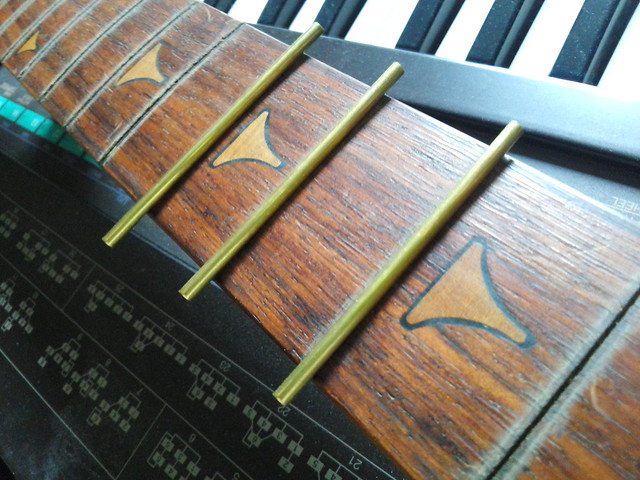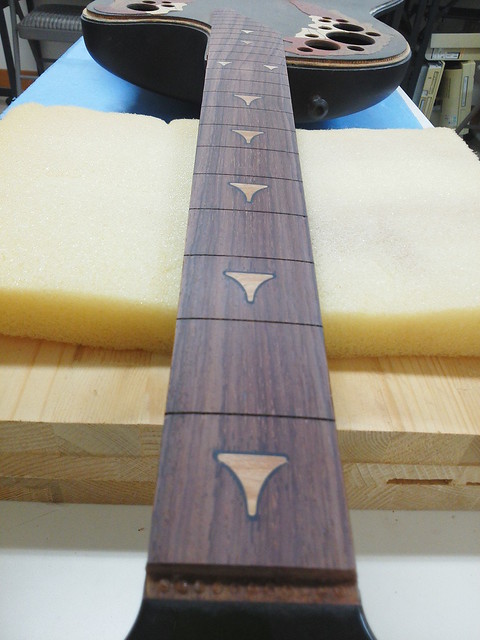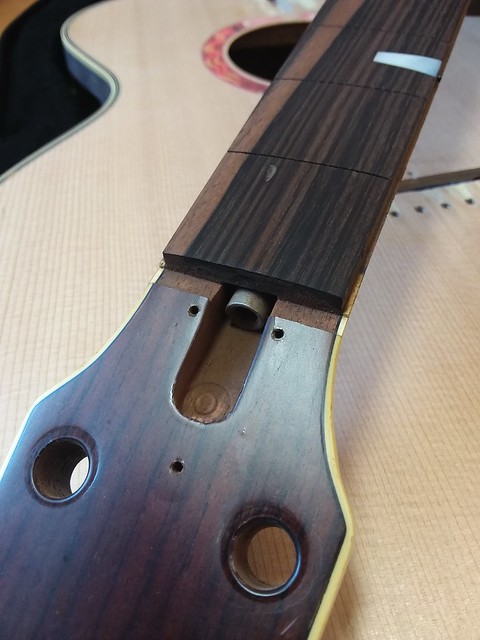|
| ||
| The Ovation Fan Club | ||
| ||
| Random quote: "Got time to breathe, got time for music." --Briscoe Darling. |
 worn ukulele neck? worn ukulele neck?
| View previous thread :: View next thread | |
| Member Communities -> Bottom Feeding Luthiery Guild | Message format | |
| d'ovation |
| ||
Joined: December 2003 Posts: 855 Location: Canada | So this is not about Ovation but I am hoping that tye BFLG masters can provide some opinion. Last week while I was on Hawaii for vacation I found this (at least 40 years) old 6-string ukulele. It has a lot of mojo, and the Koa fretboard is quite worn and discolored between the frets, with a noticeable "pit" at almost every spot up to about the 6th fret. I think that it plays great and all notes can be fretted cleanly, but cosmetically it looks a bit too rugged for my liking. I assume that there are few approaches ranging from simple clean and polish, to sanding between the frets, to a complete fretboard replacement. At this point I don't really consider the costly replacement option, but am wondering if a sanding and leveling would be reasonable to remove the numerous "pits" or if there is way to also fill those "pits" to keep the dimensions of the fretboard as close to original. | ||
| |||
| alpep |
| ||
Joined: December 2001 Posts: 10583 Location: NJ | it can be filled but it will never look the same. I'd leave it play it love it | ||
| |||
| FlySig |
| ||
Joined: October 2005 Posts: 4075 Location: Utah | Some amount of sanding the fretboard is possible. The frets would have to all be pulled, then the fretboard beam sanded, then refretted. The limiting factor would be how thick the fretboard is. If it is thick enough, the divots could be sanded out. Sanding does clean up the fretboard quite a bit even if you don't take much off. It wouldn't clean up any remaining divots but it would clean up the level parts of the wood. Stewmac had a video filling the divots in a darker wood, either Rosewood or Ebony. The fills were visible. I would guess Koa would show the fills much worse. | ||
| |||
| Love O Fair |
| ||
Joined: February 2016 Posts: 1876 Location: When?? | I'm with Al. if it still frets nicely I'd leave it. Plus, if it doesn't plane out like to you hope it will (which I've had happen) then you're stuck with it. That's just my own superstitions speaking, with letting the gods of historical aesthetic character have their way. Edited by Love O Fair 2018-11-29 7:12 PM | ||
| |||
| BCam |
| ||
Joined: October 2014 Posts: 270 | A lot depends on the nature of the fretboard. If the fretboard and neck are one piece, like my 1957 Kamaka, I'd leave it alone. If it's a separate, glued-on fretboard, it may be thick enough to sand and refinish or even replace. Personally, I'm with Love O Fair, it's a 40 year old uke, not a new one so relax and play it. In any case, there's no downside to a gentle clean and polish. Under no circumstances would I attempt to fill the "pits". | ||
| |||
| arumako |
| ||
Joined: October 2012 Posts: 1091 Location: Yokohama, Japan |
Nice comments everybody! Hope you don't mind my chiming in d'ovation. Since your Uke is "at least 40 years old" it probably has a flat fretboard? If it does, radiusing the fretboard will take out the pits (at least near the edges), and make the Uke even easier to play. When working on my 1868-5 Rebuild (in its final stages now), the fretboard was in pretty bad shape. It had the usual Ovation standard 10" radius, but Yamaha's 16" radii feel pretty comfortable to me; so the 1868 fretboard radius was compromised and sanded to 12". Here's a pic before the radiusing. You can see there is a lot of grain lifting on the fretboard (unfortunately, the pits in the 4th fret and lower position are not pictured, but the pits were kind of deep in the shape of the open "D Major" chord.
After sanding with the 12” radiusing block, the fretboard really cleaned up nicely. The larger radius meant the middle area was sanded down with little change in the overall depth of the fretboard at the edges. To my pleasant surprise, the pits were also removed quite nicely.
Here's a Yammy (CPX10) in the rebuild process right now. The fretboard on this one was severly pitted. Even after resurfacing, there was one pit just before the 1st fret that was too deep to sand out. Yammy fret boards are pretty thick so "thickness is not an issue here"; however, if I sanded deep enough to eliminate the pit, the position markers would be at risk!
This one will be filled with a mixture of rosewood dust and CA glue. It will not be invisible, but will be hidden to all but the most suspecting eyes. Whenever I sand any kind of wood, I make sure to keep plenty of sawdust in small sealable baggies. When labeled properly, they really come in handy when something like this happens. One of the things you'll notice is that the pit stands out if not filled, and looks pretty fugly. With 40 years of use, if your Uke has 4 or 5 of these across the fretboard, it will look pretty funky even if you fill it with a Koa/CA mixture. Don't know if this is helpful at all, but I guess that's my 2 cents worth! Ooh, class starts in 5 minutes! Yikes! Good luck d'ovation. Edited by arumako 2018-11-30 6:09 PM | ||
| |||
| Jump to page : 1 Now viewing page 1 [25 messages per page] |
| Search this forum Printer friendly version E-mail a link to this thread |
| This message board and website is not sponsored or affiliated with Ovation® Guitars in any way. | |
| (Delete all cookies set by this site) | |






